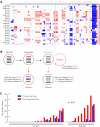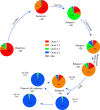Clonal competition with alternating dominance in multiple myeloma
- PMID: 22498740
- PMCID: PMC3412330
- DOI: 10.1182/blood-2012-01-405985
Clonal competition with alternating dominance in multiple myeloma
Abstract
Emerging evidence indicates that tumors can follow several evolutionary paths over a patient's disease course. With the use of serial genomic analysis of samples collected at different points during the disease course of 28 patients with multiple myeloma, we found that the genomes of standard-risk patients show few changes over time, whereas those of cytogenetically high-risk patients show significantly more changes over time. The results indicate the existence of 3 temporal tumor types, which can either be genetically stable, linearly evolving, or heterogeneous clonal mixtures with shifting predominant clones. A detailed analysis of one high-risk patient sampled at 7 time points over the entire disease course identified 2 competing subclones that alternate in a back and forth manner for dominance with therapy until one clone underwent a dramatic linear evolution. With the use of the Vk*MYC genetically engineered mouse model of myeloma we modeled this competition between subclones for predominance occurring spontaneously and with therapeutic selection.
Figures






Comment in
-
Multiple myeloma: evolution by alternating dominance.Nat Rev Cancer. 2012 May 17;12(6):376-7. doi: 10.1038/nrc3285. Nat Rev Cancer. 2012. PMID: 22592301 No abstract available.
-
Darwinian evolution and tiding clones in multiple myeloma.Blood. 2012 Aug 2;120(5):927-8. doi: 10.1182/blood-2012-06-430645. Blood. 2012. PMID: 22859708
References
-
- Anderson K, Lutz C, van Delft FW, et al. Genetic variegation of clonal architecture and propagating cells in leukaemia. Nature. 2011;469(7330):356–361. - PubMed
-
- Notta F, Mullighan CG, Wang JC, et al. Evolution of human BCR-ABL1 lymphoblastic leukaemia-initiating cells. Nature. 2011;469(7330):362–367. - PubMed
-
- Shah SP, Morin RD, Khattra J, et al. Mutational evolution in a lobular breast tumour profiled at single nucleotide resolution. Nature. 2009;461(7265):809–813. - PubMed
Publication types
MeSH terms
Associated data
- Actions
- Actions
- Actions
- Actions
Grants and funding
LinkOut - more resources
Full Text Sources
Other Literature Sources
Medical
Molecular Biology Databases

